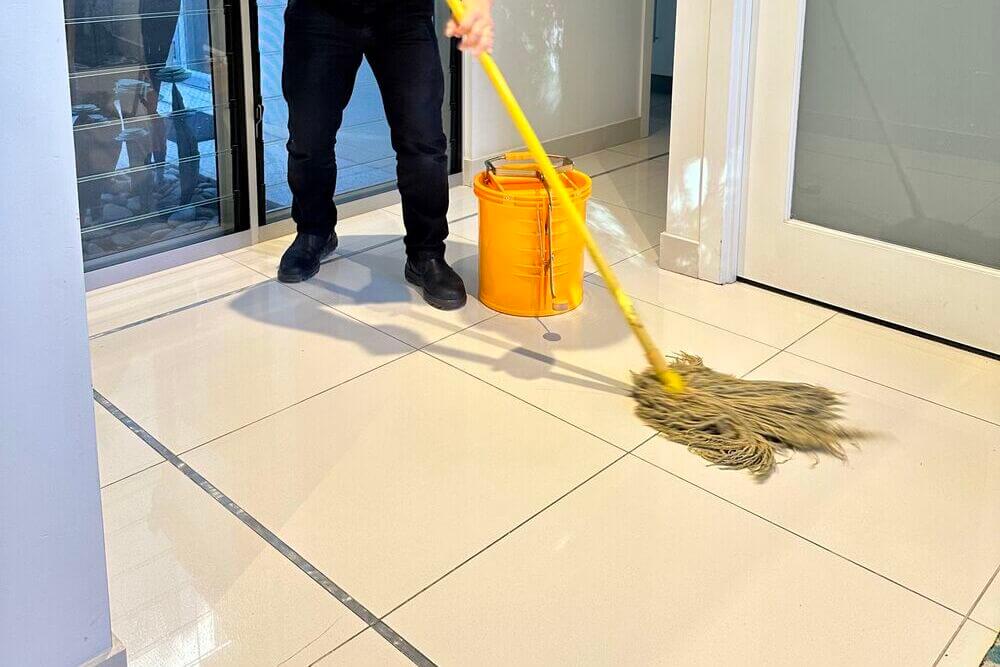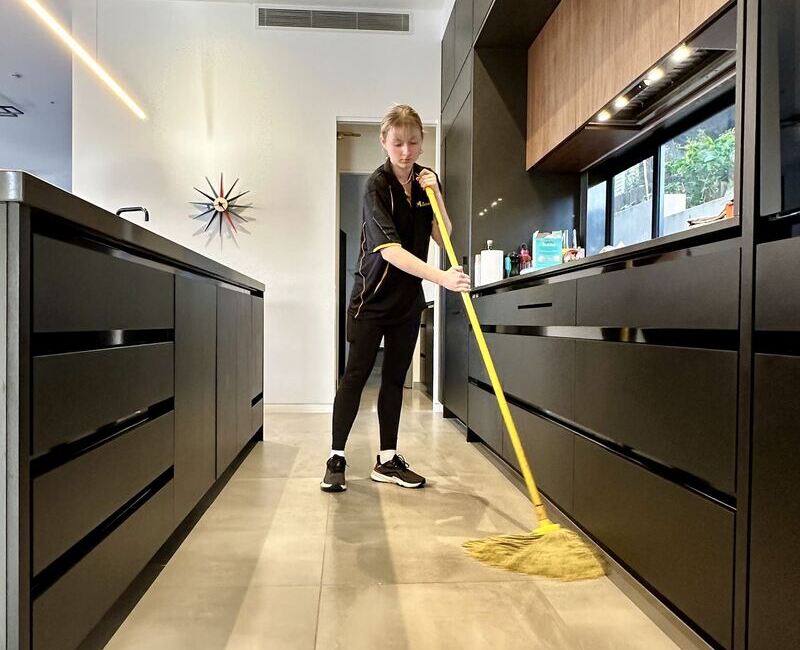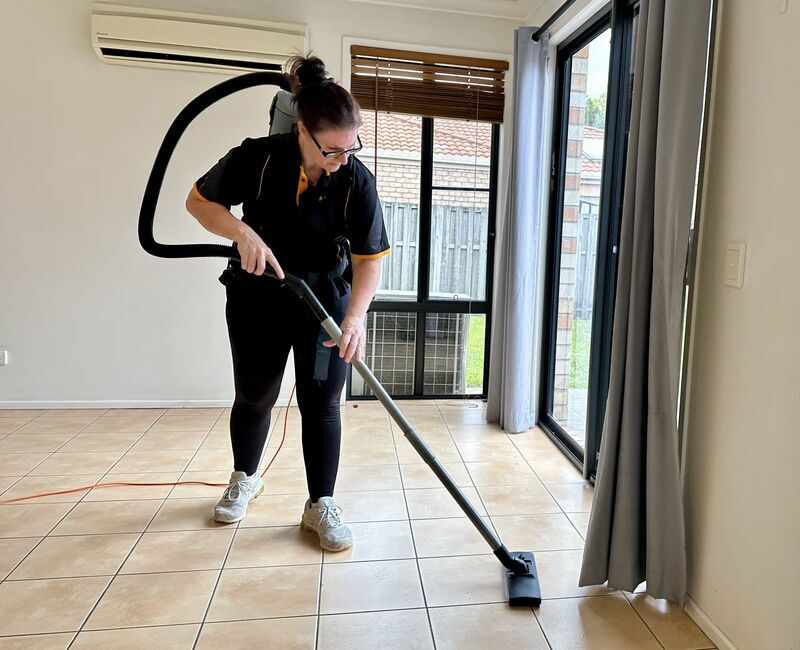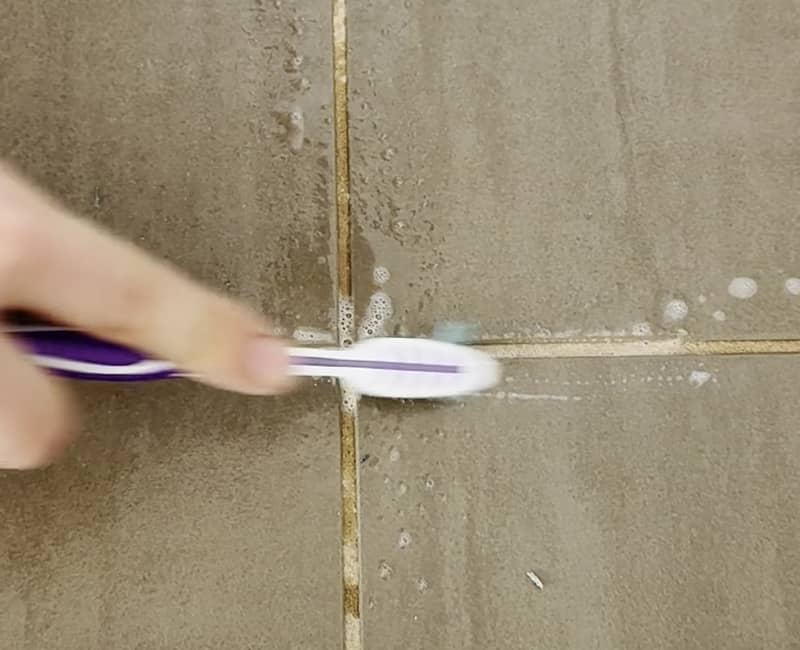Tiles are such a versatile covering — they can go on walls or floors, and they can be made of ceramic or stone or wood. However, many of us have tiles in high-traffic areas, which means they see lots of dirt.
And no matter how clean the rest of the space is — if your tile floors are dirty, the whole room feels dirty!
Knowing how to clean tile floors not only ensures your room looks tidy, but also helps prolong the lifespan of the tiles and grout. Use the appropriate cleaning methods and tools so you don’t damage the material.
Whether you need to clean sleek marble tiles or practical ceramic tiles, we’ve got you covered!
Preparing to Clean | Ceramic or Porcelain | Glass | Marble | Other Natural Stone | Resilient | Terracotta | Wood | Cleaning Grout | Removing Stains
How Often to Clean Tile Floors
Routine cleaning keeps your tile floors in good condition! It prolongs the life of your tiles and ensures your home is clean and hygienic.
Sweep or vacuum a few times a week to lessen loose dirt and dust. If you have pets or small children, or live near a major road, you’ll need to vacuum more often.
Clean the tiles and grout once a week, or once every 2 weeks for low- to medium-traffic areas. This includes mopping the floors and spot-cleaning any grout stains.
Deep clean tile grout once a month, and re-seal every 6 months (or according to the installer’s instructions).
Tired of fighting floor dirt every week? Maid2Match’s professional house cleaning services can tackle the job for you!
Before Cleaning Tiles: What to Know
Tiles may be durable and low-maintenance, but it’s still best to use appropriate tools and cleaning solutions!
What is the best thing to clean tile floors with?
Choosing a good tile cleaner makes cleaning easier and more efficient. It also protects the tiles, since an incorrect product could discolour, degrade, or even damage the material.
Here’s what you should clean your floors with, based on the tile material:
- Ceramic or porcelain: Mild detergent or commercial cleaner
- Glass: White vinegar
- Marble: pH-neutral or stone cleaner
- Other natural stone: pH-neutral cleaner or mild soap
- Resilient tiles: White vinegar, mild detergent, or specialised cleaner
- Terracotta: Mild soap
- Wood: Wood floor cleaner
Besides the cleaning solution, you’ll also need the following tools:
- Grout brush
- Microfibre mop
- Vacuum cleaner
- Soft cloths or towels
- Soft-bristled broom or dust mop
Be sure to wear protective equipment when cleaning, including rubber gloves and a face mask.
What to avoid when cleaning tiles
Avoid sponge or string mops, which are less absorbent than microfibre. Sponge mops tend to push water around, while string mops can leave excess moisture and streaks.
Do not use abrasive cleaners (like metal brushes or steel wool), which can scuff or scratch the tile surface. When removing dirt, use a soft-bristled broom or a vacuum with the correct attachment.
For natural stone surfaces, skip any acidic cleaners, which can etch or discolour the material.
Avoid harsh chemical cleaners like bleach unless necessary, since these can damage the glaze or coating on your tiles. If needed, follow the package instructions carefully!
Additionally, you shouldn’t use toilet cleaner on shower tiles — or any tiles, for that matter. The product can ruin the finish and leave a residue that’s difficult to wash off.
Preparing to Clean Tile Floors
Before you start mopping the tiles, move the furniture out of the way! This gives you access to the entire floor, especially hidden spaces like underneath couches.
Make sure to sweep or vacuum the floors first. This prevents any grit from scratching or dulling the surfaces, and ensures you don’t push dirty water around.
Prep your tile cleaner and equipment so everything is on hand. For mopping, use one bucket for your cleaning mixture and another for clean water.
Wring out your mop after dipping it in the floor cleaner — you want it damp, not dripping! Also, rinse the mop regularly, and change the cleaning solution or mop water once it becomes cloudy.
Cleaning Floor Tiles by Type
Most household tiles are made of ceramic, porcelain, and other durable materials that are fairly easy to clean.
On the other hand, stone tiles need more specialised cleaners as the material can be more delicate. Look for pH-neutral products or dedicated stone cleaners.
We’ve asked some of our Maid2Match pros about the best way to clean tile floors, depending on the type of tile.
How to clean ceramic or porcelain tiles
Ceramic and porcelain tiles are both made of fired clay, with slightly different compositions and price points. Both are durable and moisture-resistant if sealed correctly, and they’re easy to maintain.
To deep clean porcelain or ceramic tile floors, choose one of these solutions:
- 1/4 cup of mild detergent per 3 litres of water
- Commercial floor cleaner (dilute according to package)
Dip your mop into the mixture and wring out the excess water. Start from the corner furthest from the exit, and work your way towards the door.
Use firm, overlapping strokes that go back and forth over the tiles.
If you’re cleaning tile walls, use a microfibre cloth to apply the solution to the surface. Work from top to bottom so you don’t drip dirty water onto already-clean surfaces.
Rinse off any residue with a clean mop and fresh water, then dry the tile surface with a soft cloth.
How to clean glass tiles
More people are choosing glass tiles for bathrooms or kitchens, since they can be coloured or styled in a lot of ways. They’re also fairly resistant to stains and moisture.
No need for any commercial glass cleaner — just mix 1/4 cup of vinegar per 1 cup of water, plus a few drops of dish soap in a spray bottle.
Spritz the cleaner onto the glass tiles and let it sit for a few minutes. Wipe the surfaces clean afterwards with a microfibre cloth or mop.
Use firm, back-and-forth strokes, and rinse the floor afterwards. Dry the glass tiles with a clean towel or mop for a streak-free finish.
How to clean marble tiles
Marble looks classy and luxurious, but it’s a high-maintenance floor material! Besides regular cleaning, you’ll need to re-seal the tiles at least once a year.
To clean marble floors, start by sweeping with a soft broom or dust mop. That way, you won’t scratch the surface.
Use a pH-neutral marble cleaner for damp mopping. Acidic cleaners like lemon juice or vinegar will etch the surface!
Minimise the moisture used when damp mopping
After washing the marble tiles, rinse off any residue and thoroughly dry the surface. This minimises the risk of leaving residue that could make the marble a slipping hazard.
How to clean other natural stone tiles
Other natural stones used for tiles include granite, slate, and travertine. Travertine in particular is a very porous material, so minimise the moisture used when cleaning!
For cleaning natural stone tiles, opt for a pH-neutral stone cleaner or detergent. Do not use anything acidic or abrasive.
After dipping a microfibre mop or cloth into your preferred cleaner, wring it out so it’s just damp. Use light, back-and-forth strokes when cleaning and be mindful not to saturate the tiles.
Dry off any excess water immediately.
How to clean resilient tiles
“Resilient” tile materials include cork, linoleum, and vinyl — any floor covering that is not clay, stone, textile, or wood.
They’re called resilient since they can be stretched or compressed but will return to their original shape. Resilient tiles are low-maintenance and usually water-resistant.
When cleaning resilient tiles, you can use a mix of mild soap and water or a dedicated tile cleaner. If you have streaks on linoleum and vinyl tiles, wash them with a mix of 1/2 vinegar per 1 litre of water.
Rinse off any residue before drying the tiles to prevent streaks or water spots.
How to clean terracotta tiles
Like porcelain and ceramic, terracotta is also made of kiln-fired clay. However, it is fired at a lower temperature and often has no glazing, so it’s more porous.
Quarry tile is an engineered form of terracotta made of natural clay and pulverised stone.
You can clean both terracotta and quarry tiles with a damp mop and mild soap with water. Avoid using anything acidic or abrasive, which may scuff the surface.
How to clean wood tiles
When cleaning timber flooring tiles like parquet, you’ll need either a mild detergent or a wood floor cleaner!
Start by sweeping with a soft broom or dry-mopping with a microfibre mop. You can use a vacuum if it has a setting that’s safe for hardwood.
For mopping, minimise the water used, as excess moisture can cause the wood to warp or swell. Dry the wood tiles immediately after to prevent water spots.
Cleaning Grout Lines
Besides cleaning your tile floors, you’ll also need to clean the tile grout! Dirty grout can make even the most pristine of tiles look grimy.
Traditional grout in houses is cement-based, which is porous and only water-resistant if sealed. Over time, grout absorbs dirt, water, and other substances, and can develop mould.
For porcelain or ceramic tiles, you can use a homemade grout cleaner of 1 part 3% hydrogen peroxide and 2 parts baking soda. Let the paste sit on the grout for 15 minutes, then use a scrub brush to remove dirt.
Wipe off the residue with a damp cloth, then let the grout dry.
For natural stone grout, use a stone grout cleaner. Hydrogen peroxide can discolour stone, so it’s best to stick with a dedicated product.
How to Remove Stains from Tiles
Tackle any spills or stains ASAP — the longer they sit, the harder they are to remove.
Blot the stain with a soft cloth or paper towel. Do not rub the stain or you could push it further into the tile material.
Try washing the stained area first with mild soap and water. If that doesn’t work, treat stubborn stains with one of the following:
- Ceramic or porcelain: White vinegar
- Glass: White vinegar
- Stone: Baking soda paste or stone cleaner
- Resilient tiles: White vinegar or borax and water
- Terracotta: Oxalic acid and water
- Wood: Diluted mineral spirits or wood-safe stain remover
For commercial products, follow the package instructions for dilution and application. Rinse off if necessary.
How to Make Tile Floors Shine
Regular maintenance keeps your tiles in good condition, but foot traffic, dust, and messes can dull the shine over time.
To get your floors gleaming again, you’ll need to polish the tiles every 2–4 months.
Look for a commercial tile polish that’s suitable for the material — for example, use marble polish for marble tiles, or wood floor polish for wood tiles.
Measure your floors beforehand so you know how much product to get! The package should say how many square metres (or square feet) are covered.
Clean the tile floors and make sure they’re completely dry before polishing. Follow the product instructions and make sure you don’t apply too much, or it could leave a slippery residue.
Tips for Maintaining Tiles Between Cleaning
People install tiles all over their homes, but they’re commonly used in bathrooms and kitchens. Here are some tips for maintaining your tile floors in these spaces.
General tile care
Try to find ways to minimise grime and loose debris on your floors. Less dirt means less effort when deep cleaning!
Place door mats at the entrances so people can wipe their shoes when coming in. Alternatively, provide house slippers so you’re not wearing outdoor shoes inside.
Keep spares of your tiles in case one or more of them crack. It’s good to have a handy replacement, or a reference if you need to buy more.
Remember that you can’t clean all types of tile in the same way! Different materials have different cleaning methods, and using the wrong one can damage the tile surface.
Cleaning bathroom tiles
Bathrooms are warm and humid spaces, so the tiles and grout are more prone to grime. In particular, you want to look out for signs of mould or mildew.
Keep a spray bottle with vinegar and warm water in the shower, and spritz the shower tiles at the end of each day. This helps minimise the buildup of soap scum and limescale.
Deep clean shower tiles and other tiled surfaces once a week.
Keep your bathroom well-ventilated so it can air out, and you’re not trapping the humidity inside.
Cleaning kitchen tiles
Kitchen tiles are often exposed to many sources of dirt, from cooking spills to grease splatter. Since the floors and walls can get messy, they need regular cleaning.
Vacuum or sweep kitchen tile floors daily to keep them clear of dust and food debris. Mop the floors once a week, when you clean the rest of your kitchen.
Tackle any spills or stains immediately. Blot the mess with a clean towel or some paper towels, and use the appropriate stain remover.
FAQs About Cleaning Tiles
Now that you know how to clean tile floors, you can enjoy them… at least until they need cleaning again. But if you want to know more about tile cleaning, here are some common questions!
How to clean tile floors without leaving residue?
To make sure your tiles are clean without any residue, you’ll need to:
- Use the correct amount of cleaning product
- Rinse the floors after mopping
- Thoroughly dry the tiles after cleaning
If you’re cleaning very dirty floor tiles, you may need to apply the cleaner more than once to remove all the grime.
Why are my tiles sticky after cleaning?
If your floor tiles feel sticky even after mopping, some common causes include:
- Not rinsing properly
- Not changing the mop water
- Using too much cleaning product
Any of these cleaning mistakes will leave a residue on your floors that feels sticky and attracts more dirt.
You can go over your floors with a clean mop and warm water to wash away the residue. Make sure you dry the tiles afterwards to prevent water spots or streaks.
Can you use a steam mop on tile floors?
You can use a steam mop or steam cleaner on some types of tile — namely, ceramic, porcelain, and sealed/water-resistant resilient tiles (like linoleum).
For porcelain or ceramic tiles, however, you’ll need to be mindful of the grout lines. Steam mops are safe for occasional use on intact, sealed grout, but can damage unsealed or cracked grout.
For sealed hardwood floors, check with the manufacturer if they allow steam mopping. You may be able to steam clean sealed hardwood tiles on the lowest setting.
Do not use a steam mop for cork, natural stone, polished concrete, unsealed hardwood, or vinyl floors. The heat and steam can cause the material to swell, warp, or discolour, and can lead to mould or mildew.
Never steam-clean tile floors of any type if the tiles are cracked, warped, or otherwise damaged.




